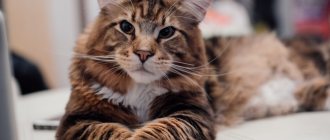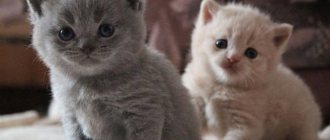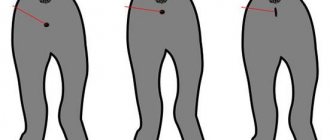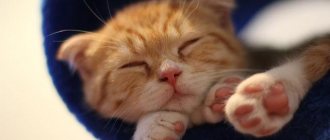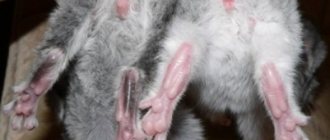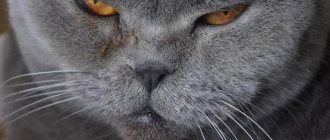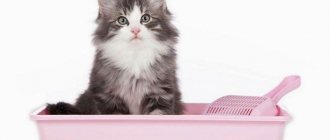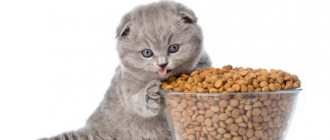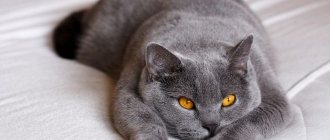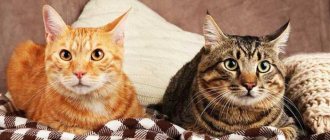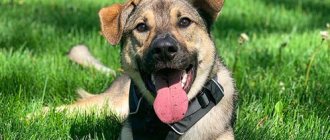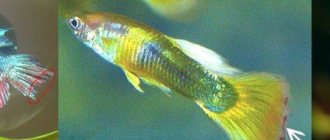Some external features
All representatives of the breed, regardless of their color, place of residence and characteristics of care, have a number of appearance characteristics. Using them, you can determine the kitten’s species:
- Round head, wide cheekbones and short neck;
- Short and straight nose, small and low-set rounded ears;
- Big eyes;
- Grounded, massive body;
- Short, but quite thick paws;
- Thick, medium-sized tail;
- Short but very thick coat.
3 month old British babies © shutterstock
When do kittens' eyes change color?
When purchasing an animal, many people pay attention to the color of its eyes. Indeed, this breed is distinguished by a beautiful shade of not only its coat, but also its eyes – gray-blue. But it is worth paying attention to the fact that as the cat grows up, it may change. It is impossible to determine the future eye color of small kittens. This can only be done a few months after birth, since by this time the animal will have completed its first molt.
It is possible to give a more accurate assessment of eye color only at one year of age, but by four months it is possible to predict the color. For the British, it depends on the coat color. At this age, experts will tell you whether the eye color will be yellow or dark orange. When choosing a small pet, it is best to pay attention to the health and condition of the eyes. They should not water, be cloudy, and the third eyelid should not be visible. The gallery below presents a selection of British kittens of different coat and eye colors.
Character of British cats
British kittens become practically independent from their owner from an early age. They can stay alone for a long time and not get bored. One should not expect excessive affection and tenderness from animals; they have a rather cold temperament. However, oddly enough, this does not mean that they do not love their owners and are not attached to them. The British will always accompany them because they want to be nearby.
Cats will not break out of your hands or resist, but will calmly withstand all attacks of tenderness from their owners.
Raising the British
Raising British kittens should begin immediately upon the pet's arrival at home. If you waste time and do not accustom him to the litter box and routine, the cat will do everything his own way. As a result, cats can fully demonstrate their independent character, and the retraining process is very complicated.
- The British captivate with their aristocracy and self-esteem. Graceful British kittens are a breed that should not be subjected to force during the training process.
- In order not to humiliate their feline pride, do not hit them in case of a mistake, just poking them with your nose and a stern voice is enough. You can splash water on the mischief maker or clap your hands loudly in front of him.
- You will not achieve a favorable result by spanking a small cat, and he may become very frightened of your hand and begin to take revenge. Think about how to raise your baby before you take him in.
- Before and after a year, the behavior of British kittens can differ greatly. At first, they are very playful, inquisitive, and love to explore all the secluded places in a new place. Then they settle down and spend most of the time sleeping or walking around imposingly, watching what is happening in the house.
- To raise an affectionate one, the attitude towards your pet must be respectful, friendly, and moderately strict. In this case, it is not difficult to tame the baby, and he can become a devoted and loving friend.
- To prevent damage to your furniture, you need to train your cat to sharpen its claws in one place where the scratching post is installed. At the moment when the cat sharpens its claws in the wrong place, the owners need to say “no” every time in a stern voice and show where to do it correctly.
Indicators of a British kitten at 3 months
At the age of three months, indicators are quite important. They reflect the correct care of the animal, the appropriate diet of the British kitten and the state of health at 3 months. At the same time, there is a slight error taking into account heredity and place of residence. Sometimes a representative of a breed may have a certain genetic deviation , therefore, when calculating development norms, it is advisable to take into account the development of both parents. The environment (ecologically polluted) can dull the development of a kitten.
How to choose the right British kitten
Sometimes you have to wait several months for a good pedigree baby from a specialized nursery. Usually kittens older than three months are given away from nurseries. At this age, babies receive all the necessary vaccinations. In the first month, the state of his health becomes clear. When choosing a baby, it would be a good idea to look at his parents along with photographs of the baby himself. You shouldn’t give up on the animal’s pedigree. Without this, even the most purebred cat becomes an ordinary yard cat. When choosing a little Briton, you cannot rely solely on his photographs.
It is better to find time and come to see your future pet in person. It is important to see it in your usual home environment. It is important to pay attention to his diet, what he is fed and what he likes. It is important to personally make sure that the animal knows what a litter box is. To do this, you will have to wait until the kitten goes to the toilet. Veterinarians advise listening to the cat - holding the cat to your ear and making sure that your furry friend does not have glanders.
At first glance this may seem strange, but the British breed sometimes has natural errors. The kitten may have deviated nasal septums and blocked tear ducts. This usually comes from the structural features of the skull.
If this is present, the animal’s eyes will constantly water and a characteristic noise will appear when breathing, similar to a quiet sniffle. When choosing a furry friend, many people advise checking the condition of his gums for the presence of gingivitis. This is not an uncommon occurrence for this breed.
Together with the animal, ask for its passport, which contains all the vaccinations given since birth. Many breeders give away his litter tray, favorite toys, and scratching posts along with the pet, but this depends on the person from whom the British baby is purchased. The breeder will also give some recommendations on care, feeding habits and other tips.
British weight at this age
When calculating the normal weight of a kitten at 3 months and relating it to the average, it is important to take into account previous indicators. First, it will give a broader picture of the animal's growth suitability. Secondly, if there is a deviation, this will make it possible to understand what moment became the turning point and where to look for problems.
British kitten aged 3 months © shutterstock
Here are approximate numbers for how much a kitten should weigh by week until three months of age and, accordingly, the weight of a British kitten at 3 months (in grams):
- 8 weeks (2 months): Cat - 1000-1700, cat - 450-900;
- 9 weeks: Cat - 1150-1900, cat - 500-1050;
- 10 weeks: Cat - 1250-2100, cat - 550-1200;
- 11 weeks: Cat - 1350-2300, cat - 750-1350;
- 12 weeks: (3 months): Cat - 1500-2500, cat - 1000-1500.
SEE THE STAGES OF KITTEN DEVELOPMENT IN THE KITTEN GROWTH TABLE
Let's consider all stages of development of kittens from birth to one year, their characteristics of maturation and growth, features of care at each age.
NEWBORN KITTENS
A newborn kitten is born weighing 80-120 grams, the size of kittens at birth is body length about 9-12 cm.
Very rarely, but still there are cases of the birth of kittens 50-70g, they are small but active. This does not always serve as a signal that the kitten is sick or has abnormalities. This also occurs in multiple pregnancies or in the case of small parents.
Newborn kittens: photo of the litter Newborn kittens are absolutely helpless during this period, they are blind, deaf, and do not know how to regulate their temperature. Newborn kittens have no undercoat; the fur is thin, weak and does not warm at all. Newborn British kittens Kittens do not know how to stand on their paws, their bones are very fragile, so babies require special care. At this time, sleep and kittens are almost inseparable concepts. Newborn kittens sleep almost constantly and eat a lot and often. Kittens need sleep for the further development of their nervous system. Newborn kittens also cannot defecate on their own; the mother cat licks their genitals and eats their feces. What is really well developed in newborn kittens is their sense of smell and touch; they easily find their mother’s nipples, fingering them with their paws, sucking and, thereby, stimulating further milk production.
Newborn kittens: photo of the litter During this period, it is better not to touch the kittens at all, just monitor their weight. Kittens should add it daily (about 10-20 grams per day), if the kitten is growing, then everything is in order.
Things to take care of:
- Set up a box for a cat (or organize a maternity house) with newborn kittens. It should be warm and dry there. The bedding should be changed (it is advisable to use white sheets to track the color of the mother cat’s discharge), because The cat will have postpartum discharge. Also, if necessary, you can put a heating pad.
- Cat food. It should be plentiful and balanced; food is a must for nursing cats. Food and water should be freely available, next to the nest box. It is also recommended to place a tray here.
Cats are by nature excellent mothers and may not leave the box for a whole week, so it is important that newborn kittens have enough milk. In the first days, the cat produces colostrum (very fatty, nutritious milk that has antibodies, thanks to which kittens develop lasting immunity).
If there are a lot of kittens, be sure to make sure that each newborn kitten gets its good portion.
The development of kittens after birth (the development of newborn kittens) is very active, so the first week can be planned out day by day.
KITTENS – DEVELOPMENT BY DAY:
1-2 days after birth, a newborn kitten only sucks milk and sleeps.
After 3-4 days, the kitten’s umbilical cord heals and falls off.
After 4-5 days , the kitten’s hearing begins to develop, and you can already observe how it begins to react to loud sounds.
HOW LONG DO KITTENS SLEEP? WHY DOES A KITTEN SLEEP ALL DAY?
If it seems to you that the kitten sleeps all the time, this is most likely normal, and there is no need to worry right away. In the first week, the kitten sleeps about 22 hours a day. Just weigh the kitten daily - this is the best indicator that everything is fine with the baby.
A newborn kitten sleeps up to 22 hours a day. How much a kitten should sleep, he decides for himself, however, if the kitten sleeps constantly and does not gain weight, first of all, pay attention to whether the kitten has enough free nipple (this happens more often if there are 5 or more kittens in a litter) , if the kitten is weak or the last born, apply it to the cat more often and do not let other kittens chase it away. If in this case the kitten behaves sluggishly and does not recover, contact your veterinarian. Kittens from birth to one month change greatly both in appearance and development, and it is important to pay close attention to this in each period. Newborn kittens in the photo, look in the pictures.
KITTEN 1 WEEK
The weight of a kitten at 1 week is 170-280 g. Week-old kittens are already starting to move more. By the end of the first week, kittens' ears open up, allowing them to hear better.
Also in the first week, you can see signs of long hair - small curls appear behind the ears.
Kitten aged 1 week
WHEN DO KITTENS HAVE EYES?
Also, by the end of the first week, the kittens' eyes begin to appear.
When do kittens' eyes open completely? How long does it take for kittens to open their eyes after birth?
Kitten 1 week:
- paws become stronger;
- the kitten sleeps a little less;
- the fur begins to “fluff”;
- the first undercoat begins to emerge;
- the kitten crawls and easily crawls towards the mother 30-50 cm;
The kittens are already a week old, and you are probably already thinking about names for them. Choose names for kittens boys and girls from “A” to “Z” here
Kittens 1 week.
Photo KITTEN 2 WEEKS old
Kittens at 2 weeks of age not only crawl, but also begin to walk, although they do this very shakily, kittens at 2 weeks behave more actively, and release their claws more and more often.
Kitten 2 weeks old: eyes begin to open
The kitten still sleeps a lot, although periods of long sleep are replaced by short periods of wakefulness. The weight of kittens triples at 2 weeks and is approximately 250-350 g. A kitten at two weeks old eats less frequently, but in larger portions, so we continue to monitor the mother cat’s adequate nutrition.
WHEN DO KITTENS' EYES OPEN?
Surely you have already wondered: what time do kittens open their eyes? - The time has come. On days 12-14, kittens open their eyes; the color of the kittens’ eyes is always blue, slightly cloudy. Kittens' eyes have already opened, but kittens begin to see approximately 15-17 days after birth.
Kitten is 2 weeks old: his hearing improves significantly, he responds to the cat’s purring and calling.
Kitten 2 weeks old
A kitten at 2-3 weeks: becomes more curious, increasingly approaches the edge of the box and looks at the world around it.
For photos of kittens at half a month, see the article. The kittens in the photo still look helpless and weak for two weeks.
Kitten with mother aged 2-3 weeks
KITTEN 3 WEEKS
The weight of a kitten at 3 weeks is 350-500 g. Kittens at 3 weeks can already hear and see perfectly, almost like adult cats. Their movements become more confident. A kitten at 3 weeks already begins to hiss and arch its back when it gets scared.
Kitten aged 3 weeks
During this period, kittens are quite active, waking time is about a third of the day. At the age of 3 weeks, kittens already begin to walk more confidently, even try to run and jump, some of them are already falling out of the box. At three weeks old, kittens still have very poor spatial orientation, so make sure that in the room where the box is located there are no objects that could injure the kitten.
At approximately 3 weeks, the first baby teeth begin to appear. When kittens are 3 weeks old, it is recommended to provide them with a litter tray. It is at this time that they begin to learn to go to the toilet on their own. Read how to train a kitten to use a litter box here.
A kitten at the age of 3 weeks already needs socialization, so play with it and pet it so that the kitten grows tame.
From now on, it is necessary to raise the kitten and be sure to achieve positive and 100% results. A kitten at 3 weeks already needs to start complementary feeding. Therefore, it is worth starting to transfer the kitten from mother's milk to soft food. From 3-4 weeks you can give soaked dry food. KITTEN 4 WEEKS - 1 MONTH
Behavior of a kitten at 1 month:
When a kitten is a month old, he behaves very actively, he doesn’t want to sit in a box at all. He flirts with his brothers and sisters, tries to bite, imitating hunting. Important games train kittens' muscles, develop flexibility and mobility.
A 1 month old kitten is very curious, he actively explores the room and finds games for himself. Be careful with sharp parts, because... a kitten can swallow a button, thread, etc.
Also during this period it is worth thinking about mosquito nets for windows, because... kittens begin to show their activity. It is important for owners to provide maximum protection for their children from falling out of the window.
How much does a kitten weigh per month?
The weight of a one-month-old kitten grows significantly and increases three times compared to birth weight. Kittens at the age of 1 month weigh approximately 400-650 grams. Read more about kitten weight here.
Photo - Kitten at 1 month
How long does a one-month-old kitten sleep?
The kitten sleeps for 15-20 hours, gradually the time of one sleep increases (since the kitten later switches to fewer feedings), but the number of hours in sleep remains unchanged.
Kittens at 4 weeks become faster, nimble, they play a lot with each other, release their claws and are already acquiring adult habits.
Scottish fold kitten 1 month old Scottish fold
At 1 month old, a kitten already has good balance, can jump, and also begins to regulate its body temperature.
The kitten is 1 month old and this is the time to actively accustom it to handling; later this will be impossible to do, and the kitten will remain a savage. Therefore, enjoy communicating with kittens, pet them and, of course, play.
When do kittens' eyes change? Do kittens' eyes change at all?
Of course, kittens change eye color gradually, this does not happen in one day, it also often depends on the eye color that the kitten will acquire in the future (green eye color takes the longest to form). Cats' eye color changes completely before they reach 2 years of age. The change in eye color in kittens is called “percoloration.”
On average, a kitten begins to change eye color at 4 weeks.
Kitten is 1 month old
By observing, you can see small inclusions; over time, the color of the kittens’ eyes will completely change from blue to permanent.
At 5 weeks, kittens begin to eat solid food and are much less dependent on their mother's milk. Each kitten should eat 100-150 grams per day. solid food. When it comes to the litter box, this is the most important time to teach them about cleanliness and hygiene. Later this will be much more difficult.
Also, kittens at 5 weeks begin to change their fur pattern, a denser undercoat appears, and the color of the pattern becomes more pronounced and contrasting.
The kitten is one month old and already needs to be dewormed.
Kittens at 1 month in the photo look quite funny, active and bring a lot of positivity. What kittens look like at one month: see photos of kittens at 1 month in pictures.
Kitten 1 month (4 weeks)
KITTEN 1.5 MONTHS - 6 WEEKS
A kitten at one and a half months already begins to wash and lick itself, learns to hunt and develops its skills with its brothers and sisters.
Kittens 1.5 months
A kitten at 6 weeks already has fairly sharp vision and formed eyes: they are pure, clear color. Kittens at 7 weeks already go to the litter box and can find it on their own. A 1.5 month old kitten can already eat solid food. From this period of time, it is necessary to take care of variety in food.
The number of meals should be at least 5 times a day and should remain this way for up to 4-5 months. A kitten at 6-7 weeks should already weigh 550-900g, continuing to actively gain weight. By the end of the kitten's second month, the intake of mother's milk is reduced to a minimum.
There is a misconception that a 1.5 month old kitten can move to a new home, but this is the biggest mistake you can make in the development of a baby. Firstly, kittens still eat their mother’s milk, which is so necessary for the development of strong immunity, and secondly, a kitten at 6-7 weeks still needs training from the mother cat. Yes, indeed, he can already eat on his own and take care of himself, but he will never become a well-mannered, clean, social and healthy cat without his mother during this period.
Also at this time you need to start accustoming to the scratching post. How to do this correctly, read here.
A 6 week old kitten already needs its first vaccination. Plan a trip to the veterinarian and get all the necessary advice on the further vaccination schedule. Kittens 1.5 months old - photos in pictures. During this period, the harmoniously formed parts of the body and the clear eyes of the kittens are already visible; during this period they are extremely attractive and cute, although a little clumsy.
The one and a half month old kitten is pictured in the article in this section.
KITTEN 2 MONTHS
The size of a kitten at 2 months increases significantly, the legs become thick, visually slightly lengthen, the tummy no longer “sticks out” so much.
Kittens 2 months old - development and care: a kitten at 2 months can already eat only solid food, it practically does not depend on its mother’s milk and sucks it, rather for peace of mind and “out of habit.” The time of such sucking can last up to six months.
Photo – Kitten 2 months
Behavior of kittens at 2 months:
a kitten at two months is already very active, curious and it is worth paying attention to its safety: the balcony doors and windows should be closed, needles and threads and small toys should be removed.
Photo - British kittens 2 months old A kitten at 2 months is still just like a child - it doesn’t understand anything, but it tries everything.
A kitten weighs 750-1,200 grams at two months.
Scottish fold kitten Scottish Straight, age 2 months
KITTEN 2.5 MONTHS
Weight of the kitten reaches 850-1,400 g. A 2.5 month old kitten needs to be trained to use a brush (comb). It is better to do this every day, not so much to comb the baby, but to understand and develop his habit of this wonderful object. Despite the fact that he has grown up, the kitten sleeps all day and this is the norm.
How to train a kitten to sleep at night?
In general, it is best to play with him during the day and in the evening, if possible, then he will get tired and sleep better at night.
Kittens sleep best next to their mother or their siblings.
British silver kitten 2.5 months old
KITTEN 3 MONTHS old
Kitten at 3 months old already sees and hears perfectly. At this age, kittens' eye color is fully formed.
At three months old, the kitten is already running around the entire apartment, perfectly oriented where the bowls of food, tray and scratching post are. During this period, he developed social skills to communicate with people. A kitten at 3 months is already purring affectionately, responds to caresses and stroking, and happily absorbs both wet and dry food.
Photo - British kitten 3 months chocolate color
At 3 months old, a kitten’s baby teeth are already fully formed. Also, a kitten needs a second vaccination at three months (the first one was done at the age of 6-7 weeks).
The size of a kitten at 3 months is increasingly larger, the weight of a kitten at 3 months is about 900-1600 grams. Moreover, the difference between male and female kittens is already clearly visible. At 3 months old, a kitten is already fully trained and ready to move to a new home. This is the perfect time to meet new owners.
Photo: kitten 3 months old, long-haired purple
Where should a kitten sleep?
The kitten sleeps where it is warm and cozy and, as a rule, chooses a secluded place . It is best if the kitten has its own bed or house, where no one will disturb it, and it will spend time peacefully in its sleep. Read the articles on how to make a bed or house for a kitten with your own hands.
Photo - Scottish Fold kitten, 3 months old, Scottish Fold, black marble
Kitten 3 months old - photos in pictures: harmonious kittens with expressive eyes and a clearly formed coat pattern. For three months, kittens become more and more like cats - more graceful and dexterous.
British kittens 3 months: photo of a blue kitten
KITTEN 4 MONTHS
Kitten at 4 months: the growth of a kitten at 4 months gradually slows down, weight, as a rule, is 1.2-1.8 kg, depending on the breed and sex of the animal.
Photo - This is what 4 month old Scottish Straight kittens look like
The behavior of a kitten at 4 months is already more and more similar to an adult cat, but children's pampering and games undoubtedly remain a priority for developing hunting skills.
Photo - this is what British kittens look like at 4 months old
At about 4 months, kittens begin to replace their baby teeth with permanent teeth. The number of meals is gradually reduced. We transfer the kitten to 4 meals a day. 4 month old kitten in the photo below.
Photo - Kitten 4 months old
KITTEN 5 MONTHS
A kitten at 5 months already weighs about 2 kg, 3-4 meals a day are enough for him.
Photo - British kitten at 5 months
At approximately 5 months of age, the kitten is vaccinated against rabies.
The 5 month old kitten in the photo is more courageous and strong. At this age, the bone structure becomes denser, the chest becomes wider, and the color begins to even out.
Photo - kitten 5 months old, white color
KITTEN 6 MONTHS
A kitten 6 months old already looks like a fully formed animal, the body is harmonious, the grace inherent in cats appears in movements and jumps.
This is what British kittens look like at 6 months
Kittens should have permanent teeth by 6 months of age. You should also visit a veterinarian and check for all vaccinations; perhaps the schedule will be created individually for your pet.
Kitten 6 months: photo below.
Photo - kitten 6 months, blue tortoiseshell color
KITTEN 7 MONTHS
A kitten of 7 months is already reaching puberty.
Also at this age, the animal most often sheds, especially if this period occurs in the autumn and first winter months. It is important to comb the kitten thoroughly, because... he licks himself and swallows his fur. Make sure you have a soft brush at home with round tips.
It's time to think about castration and sterilization.
Photo - British kitten 7 months old, silver chinchilla color
KITTEN 8 MONTHS
8 months old Kittens are already considered relatively mature animals.
During this period (ideally 8-10 months), it is necessary to spay and neuter your pet.
After a year, this is no longer recommended.
Photo - British kitten, 8 months old, golden color
KITTEN, 9 MONTHS OLD
A kitten at nine months old already looks like an adult animal.
Photo - Kitten 9 months old
Kitten 10 months old
A kitten at 10 months old is considered sexually mature. During this period, cats and female cats can already actively demand mating. If you decide that you will not spay or neuter, then you need to remember that animals should not be bred until they are one year old. Despite the fact that the pet looks like an adult, it is not one at all, and early matings can lead to serious consequences. The size of the cat at this time is already significantly larger than the size of the cat; these differences can be more than 1 kg. If you have a show animal, then you need to know that from the age of 10 months, kittens participate in the adult class on an equal basis with adult animals and have the right to receive appropriate nominations and titles.
Photo - kitten 10 months old
KITTEN 11 MONTHS
A kitten stops growing at eleven months.
It should be fed little by little with food for adult animals. The transition should be very smooth so as not to injure your pet’s digestion.
The number of meals can be reduced to 2-3 times a day.
Photo - kitten 11 months old
KITTEN 12 MONTHS - 1 YEAR
A kitten at 12 months has the right to be called an adult animal.
By this time, it is necessary to complete all vaccinations for the first year of life, castrate/sterilize, and transfer the pet to food for adult animals.
British cat, 1 year old, silver chinchilla
How old do kittens grow?
A kitten is 1 year old - this is exactly the moment when the kitten stops growing, it becomes an adult graceful animal. In general, cats and cats grow stronger until they are 2-2.5 years old.
British cat, 1 year, lilac color
Don't forget to monitor your pet's health, visit the veterinarian regularly, and get all the necessary vaccinations on schedule!
British golden tabby cat, 1 year old
Let your pet grow beautiful, healthy and certainly make you happy!
| In our cattery you can “buy a real British kitten.” We have many different colors, we will help you choose and answer all your questions! |
Type of food and its features
A very important question is what to feed a British kitten for 3 months - ready-made food or natural food. When choosing the first option, you need to know that one manufacturer must be maintained throughout the development of the kitten, since each food has its own specific set of nutritional values and ingredients. If such a set changes, the British body may not yet be formed and refuse to accept the new food. If you choose natural food, it is worth noting that it is important to know the nuances of what you can and cannot give to your pet.
In addition, if you have chosen the option of buying a kitten in a nursery, then you need to inquire what method of feeding was chosen there for your animal.
Because it is advisable to continue to use the same dry food, but certain preferences may have already developed towards using a natural product.
What a British cat shouldn't eat
It is also important to understand what you absolutely cannot feed an animal:
- Low quality dry food like Whiskas, Friskas, Kitiket. They, of course, are not as expensive as premium products, but such savings will not bring benefits. The composition speaks for itself - horns, hooves, feathers, aromatic additives.
- Food from the master's table. By the way, this is a common mistake of many owners who lovingly feed furry beggars borscht, cutlets, canned food, and sausages.
- Although meat is very good to include in the diet, not all types are equally healthy. Thus, fatty varieties are strictly contraindicated. For example, lamb.
- Under no circumstances should you feed salty, spicy, smoked or sweet foods! Spices are also not welcome.
- Vegetables and fruits are recommended for furry pets, but not all. Eggplants, for example, are even recognized by veterinarians as dangerous to cat health. Just like onions, garlic, potatoes, citrus fruits.
- It is theoretically possible to eat river fish, but in reality there is a high risk of small bones getting into your pet’s body.
Dry food at 3 months
This method is convenient in that the owner can independently calculate in detail the amount of product needed for consumption. In addition, it is convenient to use on the road and saves a lot of time. At the same time, it is important to know that all food is divided into wet and dry . It is the first category that is suitable for feeding British kittens at 3 months, since they consist of 80% water and are therefore better digestible. They are safer and do not injure the British esophagus and stomach.
© shutterstock
When changing food to an analogue for an animal aged 3 months, an allergic reaction may occur. This is why you should give preference to one manufacturer and simply vary between tastes.
About the breed
The breed standard dictates the picture of the external characteristics of the animal. What does a British kitten look like: round cheeks, straight ears, a powerful body with a large chest, strong legs and elastic, dense fur. The baby's tail is fluffy, with thick hair. Kittens differ in hair volume, color, origin, and the presence or absence of titled parents.
| Capabilities | ✓✓✓ |
| Playfulness | ✓✓ |
| Health | ✓✓✓✓ |
| Hair loss | ✓✓✓ |
| Difficulty of care | ✓✓✓ |
| Relationship with other pets | ✓✓✓ |
| Reaction to strangers | ✓✓✓✓ |
| Attachment to family members | ✓✓✓✓✓ |
Cubs are divided into three main types:
- Long-haired.
- Short-haired.
- Lop-eared.
Longhair
British longhair kittens were obtained after mating a British shorthair with a Persian cat. At first, producers considered this breed category a defect: they did not want to spoil the short-haired appearance. But later the popularity of those with softer hair began to grow. A new breed of British pet has emerged.
Shorthair
British Shorthair cats are a strong, muscular variant with short, plush fur and a thick undercoat.
British kittens photos
Colors
Usually the color is indicated in the advertisements. It is difficult to determine the color: nursery owners exhibit small British dogs in photographs. The most common options:
- tabby;
- color point;
- marble (whiskey);
- whiskey (marble);
- tortoiseshell;
- blue;
- black;
- white;
- grey;
- ginger;
- lilac;
- chocolate;
- silver;
- red;
- peach;
- beige;
- cinnamon;
- ticked;
- harlequin;
- brown.
Natural product
The advantage of this choice is the wide variety of products that are suitable for a 3 month old kitten. But the big disadvantage is that they cannot be given the food that was prepared for people. After all, it contains salt and spices, which greatly injure the British body. Every day the animal’s diet should definitely be dominated by fish and meat, which can sometimes be replaced with seafood. Such products will provide him with protein.
Also indispensable for balanced growth is calcium, which is contained in milk, sour cream and cottage cheese.
For more variety, you can use cereals and vegetables. But you need to remember about the ban on potatoes - starch is practically not absorbed by the young body of a British kitten at 3 months.
Power change
If you suddenly change the diet, you can get diarrhea in a kitten at 4 months. Therefore, you should not risk the life and health of a Briton by rushing to switch to another type of food, but gradually introduce him to food. Gradually increase the amount of new food when you feed your baby, while decreasing the amount of old food.
A meat diet is a bad option, so do not give your pet only meat at 4 months. Although they are considered carnivores, they remain omnivores, eating both meat and vegetables equally. Therefore, the diet must be balanced.
Rules for caring for a 3 month old kitten
Every British dog owner needs to know and control all aspects of caring for their pet. These include:
- Wool and keeping it looking good;
- Kitten hygiene at 3 months;
- Early castration and sterilization.
Grooming at 3 months
An important part of keeping your 3-month-old British kitten looking good is proper handling of its coat. At the same time, you need to take into account some established rules and adapt them to suit your pet. Although representatives of this breed are clean and very neat animals, they need to be bathed when they get dirty or before important exhibitions. At the same time, it is worth giving preference to high-quality, which, unfortunately, are not very cheap, cat shampoos
© shutterstock
Keep in mind that caring for a three-month-old British kitten is largely demonstrated by its appearance, and it is the fur that is the first demonstrator.
Therefore, in addition to timely bathing, to maintain the high-quality appearance of a British dog’s coat at 3 months, he needs to be given special vitamins. Such tablets or powders can be found on the shelves at a regular pet store, but it is advisable to consult a veterinarian before purchasing them. Also important purchases will be a comb and hair removal paste, which will be useful during shedding in the future.
Feed
The diet of a 4-month-old kitten is significantly different from that of an adult cat. From birth, the British gastrointestinal tract is adapted to the absorption of dairy products and milk in particular, but with the process of growing up, the ability to absorb milk sugar or lactose is lost. This process begins at 4 months.
In order for development to be harmonious and comprehensive, the diet must contain all the necessary elements. Healthy nutrition is based on a strict calculation of all necessary elements in accordance with the weight and characteristics of a particular pet at 4 months.
© shutterstock
Remember that for the British himself, the main characteristic of the “deliciousness” of food is its smell.
This must be taken into account when choosing dry food and preparing a dry diet for your baby. Kittens begin to distinguish tastes on the 11th day, so a one-month-old British kitten already clearly knows the line between sour, sweet, salty and bitter taste.
Proper kitten hygiene
Caring for a 3-month-old British dog also includes certain hygiene rules, which must be observed for each representative of the breed. In fact, doing them is not so difficult, since kittens at 3 months are very obedient and calm. Already at 3 months, caring for a kitten is almost identical to caring for an adult cat and includes the following features:
- the purity of the eyes of a British kitten;
- timely shortening of nails;
- appropriate ear care at 3 months.
Minor discharge in the corners of the eyes can be easily removed with a cotton swab or a damp cloth. In addition, you can use special lotions that can be used regularly or for significant discharge. You should consult your veterinarian regarding their use. The main rule here is the owner’s clean hands while caring for a 3-month-old British kitten.
Experts also advise trimming your cat’s claws every 2 weeks and buying a special scratching post for shortening your cat’s claws yourself. Regular cleaning is also required for your pet's ears at 3 months - about once a month. To do this, gently wipe the ears with a cotton pad moistened with hydrogen peroxide.
Sample menu by age
The nutrition of kittens changes as they grow, so the owner needs to know an approximate menu by age. The list of products in it is conditional, it is allowed to diversify it, which will benefit the pet.
Up to a month
Up to a month, kittens are usually fed by the mother with her colostrum and milk. She calculates the frequency of feeding herself for her offspring. The secretion of the mammary glands is the most suitable food for newborn kittens. It contains everything you need to create strong immunity.
Sometimes the mother cannot or refuses to feed the cubs. Then the owner will have to fatten the pets. For this purpose, a cat's milk replacer is used. The number of feedings and method of breeding are indicated on the packaging. Usually replacements are given for up to 4 weeks.
1 month
When the kitten is 1 month old, it is advisable to continue feeding it with mother's milk. If this is not possible, then a high-quality substitute. Then there is a smooth transition to solid food.
Basic Rules:
- Start introducing dairy products into your diet, but raw cow's milk is not recommended. The best option is infant formula.
- Include meat in your diet with boiled finely chopped beef or, better yet, veal.
- Gradually include porridge made from buckwheat, semolina or oatmeal.
- At the end of the first month, introduce fermented milk products: cottage cheese, yogurt.
- Give boiled liver 1-2 times a week.
Menstruating Britons eat often, but in small portions. The size of one is 30 grams. Daily amount – 5–6 times. Kittens themselves will tell you what and how much they are ready to eat, so it is recommended to focus on their preferences.
2 months
At 2 months the diet is finally formed, and the kitten begins to move a lot. Activity leads to increased energy consumption, so you can feed your pet more often - up to 8 times a day. Portion sizes remain the same as for one-month-old kittens.
The diet consists of milk porridge, cottage cheese, boiled lean meat, and egg yolks. Infant formula can remain at this age. If a mixed diet was chosen, then wet kitten food is included.
3 months
The kitten is gradually growing, so you can introduce new foods to the diet for variety.
Nutrition for 3 months:
- sea fish (boneless fillet);
- boiled vegetables mixed with chopped meat (beef, chicken, turkey);
- homemade fermented milk products that replace infant formula;
- dry granules soaked in milk or water.
The number of meals is 4–5, the size of each serving increases to 40–50 grams.
4–6 months
The diet at 4–6 months is characterized by an increase in dry food. The number of servings is reduced to 4 by six months, and the sizes become larger - up to 70–80 grams. One meal of food should consist only of dry granules. The remaining products remain (meat, vegetables, cereals, yolks, liver).
From 6 months to 1 year
The age from 6 months to 1 year is a difficult period for the owner. The kitten is finally formed and begins to show character. At this time, nutrition plays an important role.
It will only harm your digestion. Gradually, as the year progresses, the amount of dry food in the daily diet increases. Meals first become three times a day, and then two times a day for adult cats. Portions also become larger accordingly.
Early castration and sterilization of a kitten
In addition to what is needed for a 3-month-old British kitten to look good in the photo, other elements of creating a healthy lifestyle and the development of the animal are also important. Until recently, no one tried to sterilize cats and castrate cats at 3 months. However, now some specialists are choosing this innovative option. Many veterinarians still express concerns about this, and therefore whether or not to perform the procedure on a British kitten at three months is an individual choice.
© shutterstock
However, you should know that all vaccinations should be completed 3 weeks before the operation and it is advisable not to feed the animal twelve hours before the operation.
Sterilization mainly occurs under general anesthesia and has several methods of implementation. Castration usually occurs under local anesthesia and secure fixation of the pet.
Ideal age to move
Many future owners want to monitor the growth and development of a British baby from an early period, at least from four weeks. But it is absolutely forbidden to take such a pet away from its mother.
By 12 weeks, a British kitten is more or less ready for independent living. It is at this age that the baby stops sucking mother’s milk, learns to eat solid food, and his own immunity begins to develop.
It is the mother who must do the weaning. If this procedure is carried out forcibly, then, in addition to health problems, behavioral disorders will certainly arise. Early weaning is also fraught with the development of diseases of the respiratory system, diarrhea and, as a result, dehydration.
Both vaccinations against panleukopenia, calcivirus and rhinotracheitis have already been carried out, which means the baby has immunity to these diseases.
The kitten is physically strong enough to move. At two or three months he received from his mother the skills of using a litter tray.
When parting with its mother early, the emotional state of a British kitten suffers greatly, since it is she who teaches how to communicate with people and other animals. A three- to four-month-old baby perceives new faces not with fear, but with curiosity. Therefore, it is worth listening to the opinion of the breeder and picking up a British kitten from the nursery at 12, and sometimes at 16 weeks.
Is it possible to identify a Briton by his behavior?
The character of a British cat is also a serious marker of the species in question. It begins to manifest itself in childhood, and over time acquires all the required features:
- autonomy and independence;
- desire to be alone;
- habit of sleeping a lot;
- tolerates long absence of the owner from the house without any problems.
All basic character parameters can be adjusted only in childhood, but you should not expect that the British dog will become sociable, affectionate and strive for constant communication with the owner.
In the early period, ground rules for living together are laid down and red lines for unacceptable behavior are drawn. If everything is left to chance, the kitten will eventually turn into an aggressive cat that will bite, scratch and make its own rules in the house.
Can street kittens be like the British?
In childhood, all babies are similar to each other. Of course, if you place a mongrel cat next to a Briton, the difference between them will be visible to the eye. But it is almost impossible to distinguish a litter, especially if the kittens come from short-haired parents, without the help of a specialist for the following reasons:
- All newborn kittens are fluffy. Later they will be divided into short- and long-haired, but at first they all have the same coat.
- Characteristic breed features, for example, round cheeks, are almost invisible at an early age.
- There is always a risk of giving birth to mestizo (a cross between British and outbred cats) - in this case, the chances are halved.
Kitten 1 month
The period of appearance of bear-type kittens. Month-old kittens are formed unevenly; a large body on short thick legs reminds us of a small bear. They sleep 16–20 hours, are very active, and play a lot.
Month-old kittens drink water on their own for 4 weeks, many eat wet and dry food themselves, and go to the litter box. Time to work with the kitten and adapt to the hands, teaching manners. The “change of color” of the eyes from blue to orange (for blue color), this happens gradually.
5 – 6 weeks | After 1.5 months, the kitten licks its fur and washes itself, the undercoat thickens, and the color becomes brighter.
At 7–8 weeks, babies are still drinking their mother’s milk and learning cat wisdom from her. The eyes acquired their color, became bright and clear.
Toilet training a kitten
Domestic cats usually have no problems with litter box training. In order for the kitten to understand this as quickly as possible, you need to approach this issue correctly and in a timely manner. The tray must be prepared before a new “tenant” appears in the house. As a rule, breeders train small kittens to use the litter tray in advance, before they are given to a new owner. In this case, all that remains is to buy a new tray and filler for it.
According to physiological characteristics, kittens go to the toilet immediately after eating. At first, you need to take your baby to the toilet immediately after eating. This way the kitten will understand what is required of him. You need to carefully grab the fluffy one by the belly and make sure that the kitten does “its business.” If the kitten went to the toilet in the wrong place, you should not shout at it, much less hit it. It is also not recommended to poke an animal into a puddle it has made.
Interesting read: all the information about British cats.
It is enough to tell the little one in a stern voice that they are unhappy with him. Cats understand human intonation. After this, you need to take the animal to the tray and rustle with the filler. The place where the “crime” occurred must be quickly treated with special cleaning agents so that the kitten is not drawn there by the smell. It must also be remembered that good toilet behavior is fully formed by six months. In order for a kitten to use the toilet correctly, the tray must first of all be comfortable.
